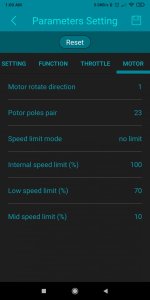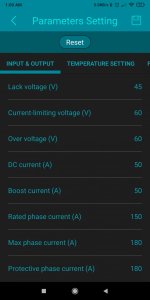GiantYukon said:
I went the 7280 because, I'm never likely to be able to put more than 80amps through any hub that I can fit on my mountain bike.
And I didnt want the controller to be too big, I havn't actually checked but I'm sure the 150 has more size.
I wouldnt mind going 72v, but I havn't really seen many aus sellers, and the ones I have seen start at $1500.
Thats why I thought my best option for acceleration would be to get an entry level sabvoton, keep it at 52v and throw some more amps at it.
I think you should play with the simulator as suggested. I was in a similar place, with similar goals, which is more acceleration but with moderate speed expectations. I experimented with various voltages and current limits, and played with the simulator before and after to "see" the effects I was feeling/observing. My main goal was to have good acceleration all the way from stop to my speed expectation, which was around 25mph.
My conclusion after all of that is that to build a bike that accelerates hard to a target speed of 25 mph, you have to build a bike that will go about 30% faster. This is due to how the torque curve peters out as it approaches top speed. It drops off so significantly that the last few mph of acceleration is at a snail pace, at least by the seat of the pant measurement.
Here's a few examples. It's easiest to view, if you turn off the power, efficiency, and load lines by toggling them off at the top of the graph.
This is what it looks like if you stay at 52V, but double the current:
https://ebikes.ca/tools/simulator.html?motor=Leaf%205T&batt=B5220_GA&cont=cust_40_80_0.03_V&hp=0&axis=mph&cont_b=cust_80_160_0.03_V&motor_b=Leaf%205T&batt_b=B5220_GA&hp_b=0&bopen=true
Better torque and acceleration off the line, but then by the time you are near target speed, it peters out like the lower amp scenario.
Same current, double the voltage:
https://ebikes.ca/tools/simulator.html?motor=Leaf%205T&batt=B5220_GA&cont=cust_40_80_0.03_V&hp=0&axis=mph&cont_b=cust_40_80_0.03_V&motor_b=Leaf%205T&batt_b=cust_104_0.2_20&hp_b=0&bopen=true
Same initial starting torque, but the curve stays flat (maximum acceleration) almost up to the target speed, and even when the curve drops off, you still have twice the torque when reaching the target speed. 104V is pretty extreme though.
Raise the current and voltage (to a reasonable level):
https://ebikes.ca/tools/simulator.html?motor=Leaf%205T&batt=B5220_GA&cont=cust_40_80_0.03_V&hp=0&axis=mph&cont_b=cust_80_160_0.03_V&motor_b=Leaf%205T&batt_b=B7223_AC&hp_b=0&bopen=true
This is more or less where I landed. Huge torque gain throughout the band, up to and past the target speed. I set my controller's three position switch to low, which limits the speed and continuous current, but still allows a lot of peak current to flow, so acceleration stays strong. I switch to middle speed if I want to hotrod around, but 99% of the time I stay in low, even on steep climbs, so it's where I want it now.
Here's possibly the scenario that your vendor is talking about. At some point, the motor won't take more current, because it's reached saturation. So even doubling the available amps won't increase the current draw of the motor (curves are idential)
https://ebikes.ca/tools/simulator.html?motor=Leaf%205T&batt=B5220_GA&cont=cust_200_400_0.03_V&hp=0&axis=mph&cont_b=cust_400_800_0.03_V&motor_b=Leaf%205T&batt_b=B5220_GA&hp_b=0&bopen=true
Don't forget to turn off the power, efficiency, and load lines so you can more easily compare the torque lines.
The bottom line is you need more battery, and you can decide after playing with the simulator if you need more voltage. The simulator assumes that your battery can supply whatever current the controller parameters are set to.









